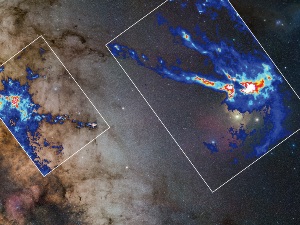Apr 11 2014
Astronomers have found a new way of predicting the rate at which a molecular cloud – a stellar nursery – will form new stars. Using a novel technique to reconstruct a cloud's three-dimensional structure, the astronomers can estimate how many new stars the cloud is likely to form.
The newfound "recipe" allows for direct tests of current theories of star formation. It will also enable telescopes such as the Atacama Large Millimetre/Submillimetre Array (ALMA) to estimate the star-formation activity in more distant molecular clouds, and thus to create a map of star births within our home galaxy.
 Cosmic nurseries: Jouni Kainulainen and his colleagues studied The Pipe Nebula (left) and the Rho Ophiuchi cloud (right) in the Milky Way. In the background, an ordinary image of the Milky Way; each inset map shows to what extent the light of background stars is dimmed as it passes through the cloud in question. These maps form the basis of the three-dimensional reconstruction of cloud structure from which the astronomers derived their "recipe for star formation". © S. Guisard, ESO (background) / J. Kainulainen, MPIA (density maps)
Cosmic nurseries: Jouni Kainulainen and his colleagues studied The Pipe Nebula (left) and the Rho Ophiuchi cloud (right) in the Milky Way. In the background, an ordinary image of the Milky Way; each inset map shows to what extent the light of background stars is dimmed as it passes through the cloud in question. These maps form the basis of the three-dimensional reconstruction of cloud structure from which the astronomers derived their "recipe for star formation". © S. Guisard, ESO (background) / J. Kainulainen, MPIA (density maps)
Star formation is one of the fundamental processes in the universe – how stars form, and under what conditions, shapes the structure of entire galaxies. Stars form within giant clouds of interstellar gas and dust. As a sufficiently dense region within such a molecular cloud collapses under its own gravity, it contracts until the pressure and the temperature inside are high enough for nuclear fusion to set in, signalling the birth of a star.
Measuring star formation rates is extremely challenging, even throughout our home galaxy, the Milky Way. Only for nearby clouds, up to distances of about 1000 light-years, are such measurements fairly straightforward: You simply count the young stars within that cloud. For more distant clouds, where it is impossible to discern individual stars, this technique fails, and star formation rates have remained uncertain.
Now three astronomers, Jouni Kainulainen and Thomas Henning from the Max Planck Institute for Astronomy in Germany and Christoph Federrath from Monash University in Australia, have found an alternative way of determining star formation rates: a „recipe for star formation“, which links direct astronomical observations of the structure of a giant gas cloud to its star formation activity.
The astronomers arrived at their result by modelling the three-dimensional structure of individual clouds in a simplified way. The data they use comes from an astronomical version of a medical X-raying procedure: As the light of distant stars shines through a cloud, it is dimmed by the cloud's dust. The dimming of tens of thousands of different stars forms the basis of the three-dimensional reconstruction, which in turn shows the matter density for various regions within the cloud.
For nearby clouds, Kainulainen and his colleagues compared their reconstruction and direct observations of how many new stars had recently formed in these clouds. In this way, they were able to identify a „critical density“ of 5000 hydrogen molecules per cubic centimetre, and showed that only regions exceeding this critical density can collapse to form stars.
Kainulainen explains: “This is the first time anyone has determined a critical density for forming stars from observations of cloud structure. Theories of star formation have long predicted the importance of such a critical density. But our reconstruction technique is the first to allow astronomers to deduce the density structure of these clouds – and to confront star formation theories with observational data.”
Christoph Federrath, who provided the numerical simulations that were used to test the new technique, adds: “With these results and the tools we developed to test theories of star formation, we can even hope to tackle one of the greatest unanswered questions of astrophysics: If stars form within a cloud of a given mass, how many stars with what kind of mass can you expect?”
Thomas Henning, director at the Max Planck Institute for Astronomy and co-author of the study, adds: “There are many observations of molecular clouds – and with the advent of ALMA, much more precise data for more distant clouds will become available. With our technique, we’re able to say: Show us your data, and we will tell you how many stars your cloud is forming right now.”
ALMA is an array of 66 high-precision microwave antennas, spread over distances of up to 16 kilometers in the Chilean desert, and able to act as a single, high-resolution telescope. ALMA has just commenced operations, and can detect clouds of gas and dust with unprecedented sensitivity, and in more detail than ever before.
Kainulainen concludes: “We’ve handed astronomers a potent new tool. Star formation is one of the most fundamental processes in astronomy – and our results allow astronomers to determine star formation rates for more clouds than ever before, both within our own galaxy and in distant other galaxies.”